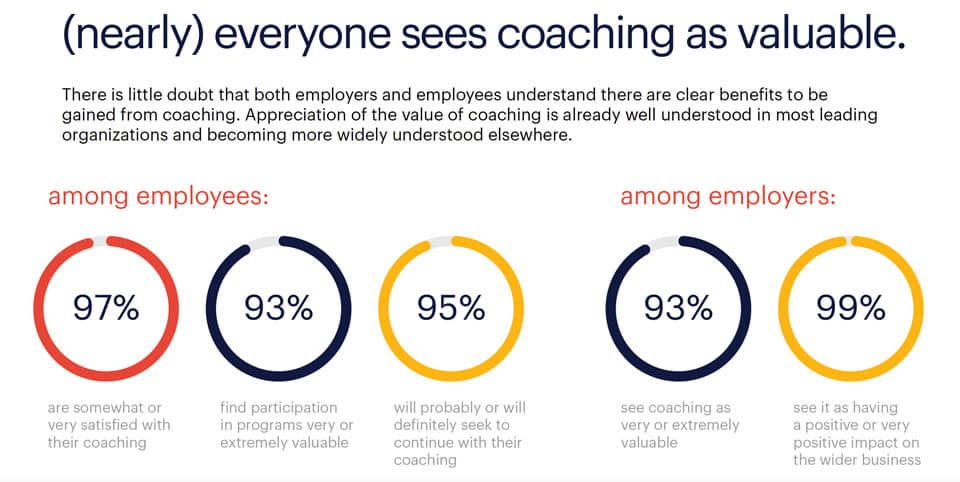Executive Coaching or Team Coaching?

There’s no denying the rise and effectiveness of executive coaching. ICF Global Coaching states, “The most recent revenue estimate for the global coaching industry was in 2023 at $4.564 billion. The increase was 62% from 2019. In 2019, the revenue was at $2.849 billion. This figure revealed a 21% increase since the 2015 estimate four years prior.” There are more than 109,200 (2022) executive coaches worldwide, a 54% increase since 2019. One-third of these coaches practice in North America.
Randstad/RiseSmart’s research underscores the effectiveness from the perspective of employees and employers alike:

Hiring professional coaches has proven to be an intelligent business strategy, yet executive coaching is also seen by employees as reserved for the privileged few and by employers as effective but not inexpensive (Randstad RiseSmart). Many organizations provide coaching for their managers and expect managers to carry the coaching load for their teams – in part to keep costs down. That said, it begs the question: Is leaving it up to managers to coach their teams the most reliable way to leverage this powerful tool and maximize a team’s potential? Probably not. What’s more, if you’re trying to make your culture inclusive, you can’t do so by making executive coaching exclusive.
“If you’re trying to make your culture inclusive, you can’t do so by making executive coaching exclusive.”
Why Coaching Individuals AND Teams is the Way to Go
From 1993 – 2002, Butch Harmon was Tiger Woods’ swing coach; he also coached Phil Mickelson and countless other Hall of Fame PGA Tour players. Harmon wasn’t a better player than Tiger, Phil, or any other pros he coached. Harmon’s gift was that he could help improve their swings and lift their overall game. Most tour players don’t typically become renowned golf coaches. Why? Because they are players, not coaches. That’s not how they’re wired. It’s not their gift. The managers in your companies are not coaches, so why would you entrust your “players” with a role most of them are not suited for?” It’s like promoting your top salesperson to sales manager. It doesn’t always go well.
In my work with Peer Advisory Groups and Forums, I coach leaders and all the members. (The same holds for my work in building high-performing teams). I don’t pretend I could do the leader’s job any better than they can, but I can help them tap into their gifts, identify blind spots, and bring a new level of energy and intentionality to their work. A big reason is that I don’t coach the leader alone; I engage the entire group because the leader is a part of the group, not apart from it. As a result, the only way to bring everyone along is to work with the entire ensemble.
“The managers in your companies are not coaches, so why would you entrust your ‘players’ with a role most of them are not suited for?”
Using this approach, everyone looks one another in the eye and agrees on what’s expected of the leader, every group member, and the group at large. With practice, these “expectation agreements” become what they do, and with coaching, they soon transition to who they are. They grow to care about one another more deeply, set high standards, and work together to serve who and what they care about.
Well-Coached Teams Maximize Learning
Well-coached groups and teams are particularly adept at operationalizing learning. When one considers the linear learning and development models that remain in so many companies today, employees go from one learning block to the next. All while being challenged to meet the growing responsibilities of their jobs without a mechanism for reflecting and choosing what and how they can apply what they’ve been taught. Coaches who also prioritize maximizing a company’s current L&D investment can help leaders and their teams adapt more seamlessly and apply more of what they learn.
Summary
Suppose employee retention, engagement, and mobility are essential to you in this increasingly tight labor market. In that case, consider your organization’s coaching as inclusive rather than exclusive. While team coaching is on the rise, coaches should challenge themselves to make this highly effective approach to building better organizations more affordable. Find a professional or coaching organization you trust that can work with your teams and those leading them. Do so cost-effectively and leverage what Growth Space states as a roughly 600% ROI. Not bad.
Have you read?
Ranked: Countries with the Most Boxing World Champions, 2024.
Ranked: The Most Charitable Countries in the World, 2024.
Revealed: Countries with the Highest Percentage of Atheists, 2024.
Revealed: Which Countries Produce The Most Major League Baseball (MLB) Players?
Revealed: Here are the least-visited countries in the world, 2024.
Bring the best of the CEOWORLD magazine's global journalism to audiences in the United States and around the world. - Add CEOWORLD magazine to your Google News feed.
Follow CEOWORLD magazine headlines on: Google News, LinkedIn, Twitter, and Facebook.
Copyright 2025 The CEOWORLD magazine. All rights reserved. This material (and any extract from it) must not be copied, redistributed or placed on any website, without CEOWORLD magazine' prior written consent. For media queries, please contact: info@ceoworld.biz








